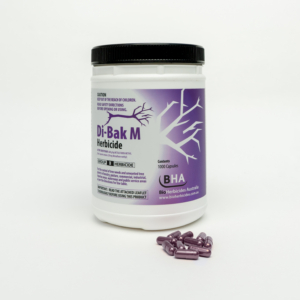Benefits of BHA technology
- Can be applied all year round and near waterways
- There is no risk to the user as the herbicide is contained within a capsule and only released once in the tree stem or trunk
- Easy to apply with a hand-held applicator
- No herbicide drift or contamination to surrounding environment
About Metsulfuron Methyl
- Metsulfuron-methyl is a residual sulfonylurea compound, used as a selective pre- and post emergence herbicide for broadleaf weeds and some annual grasses.
- It is usually used together with other herbicides that control the weeds not susceptible to metsulfuron.
- The breakdown of metsulfuron-methyl in soils is largely dependent on soil temperature, moisture content, and pH.(acidity / alkalinity) The chemical will degrade faster under acidic conditions, and in soils with higher moisture content and higher temperature.
- Metsulfuron-methyl is rapidly taken up by plant roots and foliage. It is translocated throughout the plant but it is not considered persistent.
- It is resistant to photolysis and has a soil half-life of 30 days (14-180 days). It is stable to hydrolysis and can persist in waterways.
How does Metsulfuron Methyl work?
- It works by by inhibiting cell division in the shoots and roots of the plant, and it is biologically active at low use rates.
- It is a sulfonylurea inhibitor of the enzyme acetolactate synthase (ALS) (Herbicide Group B) that is critical for the synthesis of the branch-chain amino acids valine, leucine and isoleucine that are essential in protein production.
- Affected cells stop dividing and shoots and roots die.
- It has broad activity against broadleaf and woody weeds including Pinus radiata and P. muricata.
BHA’s DI-Bak M works rapidly to cause tree/weed deterioration due to the concentrated form delivered directly to the source.
Di-Bak M is comprised of 600g/kg of Metsulfuron-methyl in a capsule dose (330mg per capsule).
http://www.bioherbicides.com.au/wp-content/uploads/Label-Di-Bak-M-PER87339.pdf

